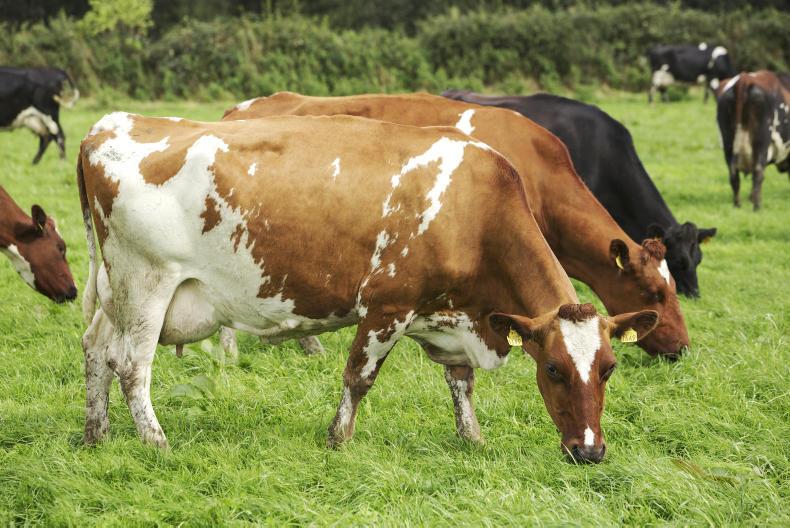Noel Griffin, his wife Sinead and uncle John Hickey run the Knocknaskeigh pedigree Norwegian Red herd in Cappoquin, Co Waterford, and, although pedigrees only make up a small portion of the herd, the breed plays a key role in the overall makeup of the large commercial herd also.
It was then that Noel’s father bought 30 British Friesian heifer calves from a neighbour, which were all bred from a stock bull and calved down in 1987. Since then, the herd has seen a steady increase to current numbers of 172 cows, made up of 30% pedigree Norwegian Reds and the rest a three-way cross of Friesian, Norwegian Red and Jersey.
However, it was not until 2004 when the family first became involved with Norwegian Reds having undertaken a trial through Moorepark.
“Herd fertility was poor at the time and, ever since, fertility has improved significantly. The Norwegian Reds imported at the time were all bred from high-fertility cows. We then bred our Friesian cows in 2003 to high-fertility bulls such as Sjkenaust (SJU) and Ulsaker (ULK), which resulted in high-fertility crossbreds and purebreds calving down in 2006,” Noel said.
Jerseys were then introduced in 2009 as part of the three-way cross trial with Moorepark and the herd has continued this way since, hence the 70% of the herd being three-way crossbred.
Production
Last year, average milk yield throughout the herd was 5,900 litres, with 498kg of milk solids being sold, touching the target set of 500kg. Targets for 2016 were set at 550kg. However, due to the poor spring, this is unlikely to be hit, with current estimates from milk recording predicting 305-day milk solids at 539kg.
Operating a 100% spring-calving system, the herd is artificially inseminated (AI) for nine weeks, with two Hereford stock bulls then allowed out for three more weeks to clean up.
When choosing bulls, all the Norwegian Reds are sourced from Geno Global through Dovea Genetics, as Geno Global is the sole distributor of Norwegian Red genetics in the world. Norway uses a total market index (TMI), which Noel focuses on when selecting his bulls for AI.
“When selecting Norwegian Red bulls, we use the TMI from Norway, while also checking the conversions into EBI. When selecting by TMI, we place particular emphasis on production indices, temperament, calving to first service/daughter fertility index and claw health,” said Noel.
“When starting the trial and the Norwegian Red breed, we would have used high-fertility bulls such as Heigre (HGZ) and Velsvik (VSK). However, over the past number of years, we have used higher production bulls such as Eggtroen (EGE), Eik (EKE) and Reitan (NR2016), resulting in a more even balance of fertility and production.
“We hope to maintain this by carefully selecting bulls who are not extreme in either trait,” he said.
Sales
With the quota abolished in 2015, the herd expanded from 157 to 172, with the hope of reaching and maintaining numbers around the 180 mark. To do this, only the top 100 to 120 cows are bred to dairy AI bulls, with the remainder getting beef inseminations.
This allows the family to get 30 to 40 heifers from their top cows, while also maintaining cow numbers. The herd then sells all calves off farm at four to six weeks of age, with the exception of replacements and pedigree Norwegian Red bulls.
The pedigree bulls are kept on farm until about one year of age, when they will be offered for sale on the Irish Norwegian Red website and sold to farmers throughout the country. Since only the top cows are selected for breeding, all bulls from these are kept to be sold as stock bulls.
Breed outlook
“With the introduction of genomic selection for selecting bulls in Norway, the improvement of the breed should only improve faster. In my opinion, more marketing of the strength of the breed needs to be done,” according to Noel.
“The cows will last for years in the herd, due to their fertility, while also reaching high yields and solids. Since the breed was introduced to the herd, hoof paring has reduced dramatically, all down to the excellent claw health of the breed.
“Often, people complain of the temperament of the cow, but once a bull with low temperament is selected, farmers will have no problem. The breed also hopes to be a polled breed within the next 20 years, with most bulls now giving 50% of their calves polled.”






 This is a subscriber-only article
This is a subscriber-only article











SHARING OPTIONS: